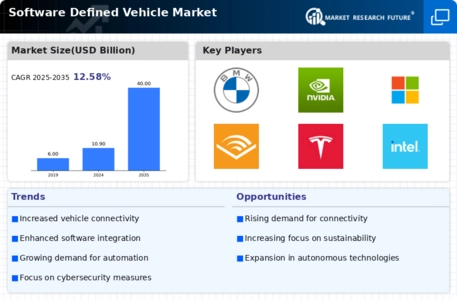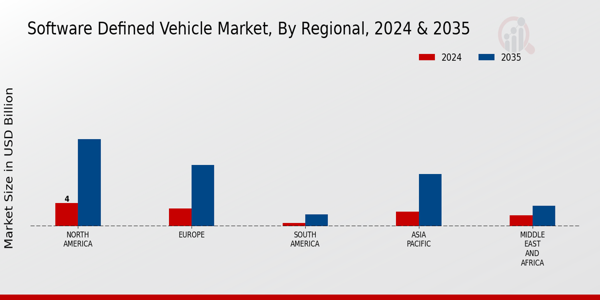Market Growth Projections
The Global Software Defined Vehicle Market Industry is poised for remarkable growth, with projections indicating a rise from 10.9 USD Billion in 2024 to 40 USD Billion by 2035. This trajectory reflects a compound annual growth rate (CAGR) of 12.58% from 2025 to 2035, underscoring the increasing reliance on software solutions in the automotive sector. As manufacturers continue to innovate and integrate advanced technologies, the market is likely to expand significantly, driven by factors such as enhanced connectivity, safety features, and consumer demand for personalized experiences.
Increased Connectivity and IoT Integration
The integration of Internet of Things (IoT) technology within vehicles is transforming the Global Software Defined Vehicle Market Industry. Enhanced connectivity enables real-time data exchange between vehicles and infrastructure, improving traffic management and user experience. As of 2024, the market is expected to reach 10.9 USD Billion, with projections indicating a growth trajectory that could see it expand to 40 USD Billion by 2035. This growth is underpinned by the increasing consumer expectation for seamless connectivity, which is likely to drive manufacturers to adopt software-defined solutions that facilitate these capabilities.
Technological Advancements in Vehicle Software
Technological advancements in vehicle software are pivotal in shaping the Global Software Defined Vehicle Market Industry. Innovations in artificial intelligence, machine learning, and cloud computing are enabling the development of sophisticated software solutions that enhance vehicle performance and user experience. The market is projected to grow from 10.9 USD Billion in 2024 to 40 USD Billion by 2035, indicating a robust demand for software-driven functionalities. These advancements not only improve vehicle safety and efficiency but also create opportunities for new business models, such as software-as-a-service for automotive applications.
Rising Demand for Advanced Driver Assistance Systems
The Global Software Defined Vehicle Market Industry experiences a notable surge in demand for advanced driver assistance systems (ADAS). These systems enhance vehicle safety and convenience, aligning with consumer preferences for smarter vehicles. In 2024, the market is projected to reach 10.9 USD Billion, driven by the integration of software solutions that facilitate features such as lane-keeping assistance and adaptive cruise control. As regulatory bodies increasingly mandate safety features, the adoption of ADAS is likely to accelerate, contributing to the overall growth of the Global Software Defined Vehicle Market Industry.
Growing Focus on Sustainability and Emission Reduction
Sustainability concerns are increasingly influencing the Global Software Defined Vehicle Market Industry. As governments worldwide implement stricter emission regulations, manufacturers are compelled to innovate and adopt software-defined vehicles that optimize fuel efficiency and reduce environmental impact. The market, valued at 10.9 USD Billion in 2024, is anticipated to grow at a CAGR of 12.58% from 2025 to 2035. This trend suggests that software solutions enabling electric and hybrid vehicles will play a crucial role in meeting regulatory requirements and consumer expectations for greener transportation options.
Consumer Preference for Personalized Driving Experiences
The Global Software Defined Vehicle Market Industry is increasingly influenced by consumer preferences for personalized driving experiences. As vehicles become more software-centric, manufacturers are focusing on delivering tailored features that cater to individual user needs. The market, valued at 10.9 USD Billion in 2024, is expected to witness substantial growth, potentially reaching 40 USD Billion by 2035. This shift towards personalization is likely to drive the adoption of software solutions that allow for customizable interfaces, driving modes, and infotainment options, thereby enhancing overall user satisfaction.


























Leave a Comment